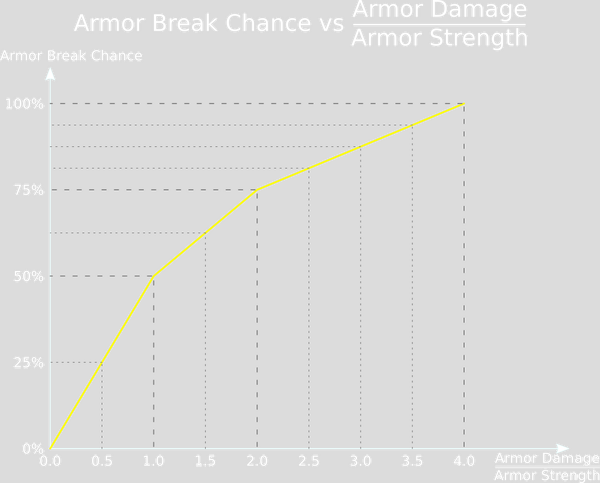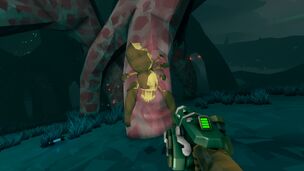Creature Armor
Most creatures on Hoxxes IV possess some degree of armor, reducing the damage dealt by dwarven weapons. It can typically be destroyed by shooting it, or avoided by shooting weakpoints or non armored body parts.
Attacks Affected by Armor
- Armor affects any attack with direct damage, no matter the damage type.
- Area attacks will not suffer damage reduction from armor, but can still break them. There must be a line of sight to the armor, and only 1 plate will receive 100% of the damage (including Armor Break increase and damage reduction from range), while up to 3 other plates will receive 25% of the damage, with other plates unaffected. (The maximum number of affected plates may vary for some creatures).
- Damage over time attacks (On Fire DoT, Electrocution…) ignore armor and can’t break or damage it, with the exception of Corrosion
Special cases
- The CRSPR Flamethrower and the Cryo Cannon are not affected by armor but can’t damage it either.
- The Breach Cutter isn’t affected by armor but can still break the armor or damage the armor plates.
- With an Armor Breaking modification equipped on a weapon, any shot that is successful in breaking off an enemy's armor plate will deal full direct damage to the enemy, regardless of the armor's damage reduction. Without it, the shot will still be affected by the armor's damage reduction upon breakage.
Types of Armor
Light Armor
Light Armor reduces incoming damage by 20%. Each shot has a chance to break it.
Glyphid Grunt, Glyphid Grunt Slasher, Glyphid Grunt Guard (on their back and legs), Web Spitter, Acid Spitter possess such armor.
Medium Armor
Medium Armor is a special type of light armor that reduces incoming damage even more.
For the Q'ronar Youngling it reduces incoming damage by 50%. Each shot has a chance to break it.
For the Glyphid Crassus Detonator, the gold plating reduces damage taken by 60%. Unlike all other Light/Medium Armor it can’t be broken.
Heavy Armor
Heavy Armor completely negates incoming damage. Depending on the creature, it either has a set health per plates, scaling with hazard level or each shot has a chance to break it.
Glyphid Grunt Guard (front legs), Glyphid Praetorian, Glyphid Warden, Glyphid Dreadnought Twins, Q'ronar Shellback, Glyphid Stingtail and Mactera Brundle possess such armor.
Unbreakable Armor
Unbreakable Armor completely negates incoming damage like Heavy Armor, but it is also impossible to break, even with Armor Break Rounds (Hardened Rounds, Tungsten Coated Buckshot).
Direct attacks are useless against it and Area damage is only effective if the area reaches vulnerable parts of the body.
Glyphid Oppressor, Glyphid Dreadnought and Dreadnought Hiveguard posses such armor.
The core of the Korlok Tyrant-Weed is also protected by a shell of Unbreakable armor but unlike the others this armor even protects the core against all kinds of Area damage and weapons that usually ignore armor such as the CRSPR Flamethrower or the Breach Cutter.
Armor Breaking
Armor Damage
The chance to break Armor and the damage done to an Armor Plate is determined by the damage done and the armor break modifier.
Armor Damage is the combination of theses two stats:
If the armor break value of a weapon isn’t displayed it is usually 100% or x1.
Any shot that hit a creature armor will damage it (for health base Heavy Armor) or have a fix chance to break it (for Light/Medium Armor or chance based Heavy Armor).
Armor Breaking modifications allows you to break an armor piece more easily by increasing your damage against armor, but your damage against creature health will remain the same. Armor Break has no effect against the Glyphid Dreadnought Shell (since it’s considered health).
Health per Plate
Only some creatures with Heavy Armor have this type of armor, namely the Glyphid Grunt Guard (Front legs only), Glyphid Praetorian and Q'ronar Shellback.
For these creatures, each armor plate has its own hidden health pool that scales with Hazard Level, using the normal difficulty scaling (same as Glyphid Grunt).
To break a plate, you need to deal as much Armor Damage as the plate's health. This amount of damage can be done is several shots, armor plates do not recover health over time.
| Creature | Armor Plate eHP | ||||||||||||||||||||||||||||||||||||||||||||||||||||||||||||
|---|---|---|---|---|---|---|---|---|---|---|---|---|---|---|---|---|---|---|---|---|---|---|---|---|---|---|---|---|---|---|---|---|---|---|---|---|---|---|---|---|---|---|---|---|---|---|---|---|---|---|---|---|---|---|---|---|---|---|---|---|---|
| Glyphid Grunt Guard (Front legs only) |
| ||||||||||||||||||||||||||||||||||||||||||||||||||||||||||||
| Glyphid Praetorian Glyphid Dreadnought Twins |
| ||||||||||||||||||||||||||||||||||||||||||||||||||||||||||||
| Q'ronar Shellback (Body and Tail) |
| ||||||||||||||||||||||||||||||||||||||||||||||||||||||||||||
| Q'ronar Shellback (Neck and Head) |
| ||||||||||||||||||||||||||||||||||||||||||||||||||||||||||||
| Mactera Brundle |
| ||||||||||||||||||||||||||||||||||||||||||||||||||||||||||||
| Glyphid Stingtail |
| ||||||||||||||||||||||||||||||||||||||||||||||||||||||||||||
Armor Strength
All other creatures use Armor Strength to determine the chance to break an armor plate. Your chance to break an armor plate will depend on the creature's Armor Strength and the Armor Damage dealt. Unlike Health Based Armor, the chance to break Strength Based Armor will be constant for each shot fired.
Any creature with Light/Medium Armor and some creatures with Heavy Armor (Glyphid Warden and Glyphid Menace) use this type of armor.
The chance for an armor plate to break is given by using the following formula to get the X value:
And then reading on the Y axis the armor plate break chance on the following graph:
| Creature | Armor Type | Armor Strength |
|---|---|---|
| Glyphid Grunt | Light |
15 Strength |
| Glyphid Grunt Slasher | Light |
15 Strength |
| Glyphid Grunt Guard (Legs and Back) | Light |
15 Strength |
| Glyphid Warden | Heavy |
15 Strength |
| Glyphid Web Spitter | Light |
10 Strength |
| Glyphid Acid Spitter | Light |
10 Strength |
| Glyphid Menace (Back Plates) | Heavy |
1 Strength |
| Glyphid Menace (Chest Plates) | Heavy |
10 Strength |
| Q'ronar Youngling | Medium |
5 Strength |
| Creatures | Armor Strength | Armor Damage needed for x% Chance | ||||
|---|---|---|---|---|---|---|
| 30% | 50% | 75% | 90% | 100% | ||
| Glyphid Grunt Glyphid Grunt Slasher Glyphid Grunt Guard (Legs and Back) Glyphid Warden |
15 Strength | 9 | 15 | 30 | 48 | 60 |
| Glyphid Web Spitter Glyphid Acid Spitter Glyphid Menace (Chest Plates) |
10 Strength | 6 | 10 | 20 | 32 | 40 |
| Q'ronar Youngling | 5 Strength | 3 | 5 | 10 | 16 | 20 |
| Glyphid Menace (Back Plates) | 1 Strength | 0.6 | 1 | 2 | 3.2 | 4 |
Resistances
All resistances and weaknesses of the creatures will apply to its armor plate as well, no matter if it is health based or strength based.
Calculating the Armor Break Chance
Calculating the Armor Damage
Example with Armor Break Chance = 80% against an Acid Spitter.
Trivia
Gallery
A Glyphid Grunt with part of its light armor destroyed.
A Praetorian with part of its heavy armor destroyed.
| |||||||||||



